International Journal of Image, Graphics and Signal Processing @ijigsp
Статьи журнала - International Journal of Image, Graphics and Signal Processing
Все статьи: 1157
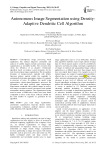
Autonomous Image Segmentation using Density-Adaptive Dendritic Cell Algorithm
Статья научная
Contemporary image processing based applications like medical diagnosis automation and analysis of satellite imagery include autonomous image segmentation as inevitable facility. The research done shows the efficiency of an adaptive evolutionary algorithm based on immune system dynamics for the task of autonomous image segmentation. The recognition dynamics of immune-kernels modeled with infinite Gaussian mixture models exhibit the capability to automatically determine appropriate number of segments in presence of noise. In addition, the model using representative density-kernel-parameters processes the information with much reduced space requirements. Experiments conducted with synthetic images as well as real images recorded assured convergence and optimal autonomous model estimation. The segmentation results tested in terms of PBM-index values have been found comparable to those of the Fuzzy C-Means (FCM) for the same number of segments as generated by our algorithm.
Бесплатно

Autonomous Multiple Gesture Recognition System for Disabled People
Статья научная
The paper presents an intelligent multi gesture spotting system that can be used by disabled people to easily communicate with machines resulting into easement in day-to-day works. The system makes use of pose estimation for 10 signs used by hearing impaired people to communicate. Pose is extracted on the basis of silhouettes using timed motion history (tMHI) followed by gesture recognition with Hu-Moments. Signs involving motion are recognized with the help of optical flow. Based on the recognized gestures, particular instructions are sent to the robot connected to system resulting into an appropriate action/movement by the robot. The system is unique as it can act as a assisting device and can communicate in local as well as wide area to assist the disabled person.
Бесплатно
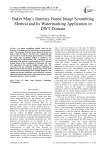
Baker Map's Itinerary Based Image Scrambling Method and Its Watermarking Application in DWT Domain
Статья научная
An image scrambling method based on the itinerary of the improved 3D Baker map is proposed in this paper. The standard 3D Baker map is improved by the tent map, so that the itinerary becomes more complicated and can be used to encode the image pixel positions to scramble the image. The scrambling method is applied to the preprocessing in watermarking. The watermark bits are embedded in the discrete wavelet transform (DWT) spectral domain based on the scrambling of watermark, the odd-even adjustment rule and the neighbor mean value. The watermark bits are embedded in medium coefficients in DWT domain of the host image. Experimental results show that the watermarked image looks visually identical to the original one and the watermark can be effectively extracted upon image processing attacks, which demonstrates strong robustness against a variety of attacks.
Бесплатно
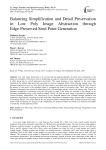
Статья научная
Low poly image abstraction is an art form that has gained popularity in recent years, particularly in the digital art community. The process involves simplifying an image by reducing the number of polygons used to represent it while preserving its overall appearance and details. This paper proposes a new approach to low poly image abstraction that utilizes edge-preserved seed points to preserve important details while reducing triangle count. The proposed approach involves six steps. First, the input image is smoothed using an anisotropic diffusion filter. Second, the entropy of each pixel in the smoothed image is computed and stored in an entropy map. Third, seed points for Delaunay triangulation are selected by identifying pixels with maximum entropy values in the entropy map. Fourth, the Delaunay triangulation is generated using the seed points as input. Fifth, colors are assigned to the triangles in the Delaunay triangulation using a color selection module. Finally, the final low poly image is generated by rendering the colored Delaunay triangulation. The effectiveness of the proposed method was evaluated through qualitative and quantitative experiments, comparing its results with other comprehensive methods using a diverse range of images from a benchmark dataset. The results showed that the proposed method outperformed other methods in preserving image details while maintaining low polygon count. Additionally, the proposed method was found to be efficient and capable of producing visually appealing results.
Бесплатно
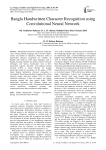
Bangla Handwritten Character Recognition using Convolutional Neural Network
Статья научная
Handwritten character recognition complexity varies among different languages due to distinct shapes, strokes and number of characters. Numerous works in handwritten character recognition are available for English with respect to other major languages such as Bangla. Existing methods use distinct feature extraction techniques and various classification tools in their recognition schemes. Recently, Convolutional Neural Network (CNN) is found efficient for English handwritten character recognition. In this paper, a CNN based Bangla handwritten character recognition is investigated. The proposed method normalizes the written character images and then employ CNN to classify individual characters. It does not employ any feature extraction method like other related works. 20000 handwritten characters with different shapes and variations are used in this study. The proposed method is shown satisfactory recognition accuracy and outperformed some other prominent exiting methods.
Бесплатно
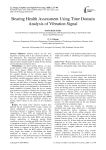
Bearing Health Assessment Using Time Domain Analysis of Vibration Signal
Статья научная
Objective: Bearing defects are the most frequently occurring fault in any electrical machine. In this perspective, this manuscript proposed a novel statistical time-domain approach utilizing the vibration signal to detect incipient faults of rolling-element bearing used in three-phase induction motor. Methodology: To detect bearing defects, six time-domain features (TDFs) namely Mean Value (µ), Peak, Root Mean Square (RMS), Crest Factor (CRF), Skewness (SKW) and Kurtosis (K) were extracted from the standard database of the vibration signal. The standard databases of vibration signals were taken from the publicly available datacenter website of Case Western Reserve University (CWRU) relating to healthy, inner raceway and ball defects of bearing. Initially, the mean and standard deviation analysis of each considered TDFs of vibration signals were performed to discriminate the health conditions of bearing. Then, the box or whisker plot method was applied to visualize the variation in each TDF in terms of median and interquartile range (IQR) value for better analysis of bearing defects. Finally, a new index parameter termed as bearing fault index (BFIT) was also computed and this parameter predicts the bearing defects based on the mean of all considered TDFs. Results: The results of the “mean±σ” analysis have depicted that all considered TDFs except µ feature are almost independent to operating loads, and have discerning potential to diagnose bearing defects. The computations of these TDFs are mathematically very simple. The box plot representation of TDFs of vibration databases have shown that peak, RMS, and skewness features outperforms to demarcate bearing health conditions in terms of median and IQR value. The results of quantitative analysis of BFIT parameter have shown that if the magnitude of this parameter is higher than 1.8 then bearing is supposed to be faulty at all operating loads of machine. Thus, the BFIT analysis of TDFs is more simple and reliable to discriminate the health conditions of bearing. As most of the available techniques rely on the multi-processing of vibration data that requires large processing time and complicated mathematical model, so the proposed method prove to be simple and reliable in identifying the incipient bearing defects.
Бесплатно
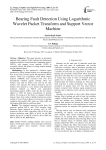
Bearing fault detection using logarithmic wavelet packet transform and support vector machine
Статья научная
Objective: This paper presents an automated approach that combines Fisher ranking and dimensional reduction method as kernel principal component analysis (KPCA) with support vector machine (SVM) to accurately classify the defects of rolling element bearing used in induction motor. Methodology: In this perspective, vibration signal produced by rolling element bearing was decomposed to four levels using wavelet packet decomposition (WPD) method. Thirty one Logarithmic Root Mean Square Features (LRMSF) were extracted from four level decomposed vibration signals. Initially, thirty one features were rank by Fisher score and top ten rank features were selected. For effective detection, top ten features were reduced to a new feature using dimension reduction methods as KPCA and generalized discriminant analysis (GDA). After this, the new feature applied to SVM for binary classification of bearing defects. For analysis of this thirty six standard vibration datasets taken from online available bearing data center website of Case Western Reserve University on bearing conditions like healthy (NF), inner race defect (IR) and ball bearing (BB) defects at different loads. Results: The simulated numerical results show that proposed method KPCA with SVM classifier using Gaussian Kernel achieved an accuracy (AC) of 100, Sensitivity (SE) of 100%, Specificity (SP) of 99.3% and Positive prediction value (PPV) of 99.3% for NF_IRB dataset, and an AC of 100, SE of 99.8%, SP of 100% and PPV of 100% for NF_BBB dataset.
Бесплатно
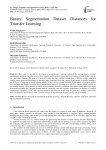
Binary Segmentation Dataset Distances for Transfer Learning
Статья научная
This work is devoted to developing a novel transfer learning approach for solving binary semantic segmentation problems that often arise on short samples in the medical (segmentation of nodules in lungs, tumors, polyps, etc.) and other domains. The goal is to optimally select the most suitable dataset from a different subject area with similar feature space and distribution to the target data. Examples show that a severe disadvantage of transfer learning is the difficulty of selecting an initial training sample for pre-training a neural network. In this paper, we propose metrics for calculating the distance between binary segmentation datasets, allowing us to select the optimal initial training set for transfer learning. These metrics are based on the geometric distances estimation of the dataset using optimal transport, Wasserstein distance for Gaussian mixture models, clustering, and their hybrids. Experiments on datasets of medical segmentation Decathlon, LIDC, and a private dataset of tuberculomas in the lungs are presented, proving a statistically strict correlation of these metrics with a relative increase in segmentation accuracy during transfer learning.
Бесплатно
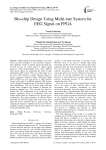
Bio-chip design using multi-rate system for EEG signal on FPGA
Статья научная
Digital Signal Processing (DSP) is one of the fastest growing techniques in the electronics industry. The signal-rate system in digital signal processing has evolved the key of fastest speed in digital signal processor. Field Programmable Gate Array (FPGA) offers good solution for addressing the needs of high performance DSP systems. The focus of this paper is on the basic DSP functions, namely filtering signals to remove unwanted frequency bands. Multi-rate Digital Filters (MDFs) are the main theme to build bio-chip design in this paper. For different purposes DSP systems need to change the sampling rate of the signal to achieve some applications. This can be done using multi-rate system where designers can increase or decrease the operating sampling rate. This bio-chip has attractive features like, low requirement of the coefficient word lengths, significant saving in computation time and storage which results in a reduction in its dynamic power consumption. This paper introduces an efficient FPGA realization of multi-rate digital filter with narrow pass-band and narrow transition band to reduce noises and changing the frequency sampling rate by factor which is required according to application. This bio-chip works on bio-signals like EEG signal.
Бесплатно
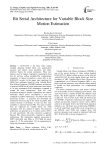
Bit Serial Architecture for Variable Block Size Motion Estimation
Статья научная
H.264/AVC is the latest video coding standard adopting variable block size, quarter-pixel accuracy and motion vector prediction and multi-reference frames for motion estimations. These new features result in higher computation requirements than that for previous coding standards.The computational complexity of motion estimation is about 60% in the H.264/AVC encoder. In this paper most significant bit (MSB first) arithmetic based bit serial Variable Block Size Motion Estimation (VBSME) hardware architecture is proposed. MSB first bit serial architecture main feature is, its early termination SAD computation compared to normal bit serial architectures. With this early termination technique, number computations are reduced drastically. Hence power consumption is also less compared to parallel architectures. An efficient bit serial processing element is proposed and developed 2D architecture for processing of 4x4 block in parallel .Inter connect structure is developed in such way that data reusability is achieved between PEs. Two types of adder trees are employed for variable block size SAD calculation with less number of adders. The proposed architecture can generate up to 41 motion vectors (MVs) for each macroblock. The inter connection complexity between PEs reduced drastically compared to parallel architectures. The architecture supports processing of SDTV (640x480) with 30fps at 172.8 MHz for search range [+8, -7]. We could reduce 14% of computations by using early termination technique.
Бесплатно
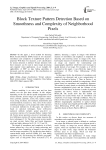
Block Texture Pattern Detection Based on Smoothness and Complexity of Neighborhood Pixels
Статья научная
In this paper, a novel method for detecting Block Texture Patterns (BTP), based on two measures: smoothness and complexity of neighborhood pixels is proposed. With these two measures, a new classification for texture detection is defined. Texture detection with these measures can be used in many image processing and computer vision applications. As an example, the applicability of BTP on data hiding algorithms is discussed, and the advantages of this classification on these algorithms are shown.
Бесплатно
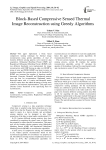
Block-Based Compressive Sensed Thermal Image Reconstruction using Greedy Algorithms
Статья научная
This paper implements a block based compressive sensing technique for thermal image reconstruction using greedy algorithms. A total of fourteen different sensing patterns were tested for data acquisition. Orthogonal Matching Pursuit (OMP) and Regularized Orthogonal Matching Pursuit (ROMP) with two different thresholds were implemented for image reconstruction with OMP having an edge over ROMP in terms of error and PSNR. ROMP was faster in terms of iterations needed for reconstruction. As the threshold for ROMP was increased the number of iterations needed decreased. Gaussian, Bernoulli and Hadamard patterns were the best for reconstruction. Hadamard matrix, Bernoulli matrix with +/-1 entries and Bernoulli matrix with 0/1 entries have the added advantage of being more conducive for hardware implementation. This paper used Discrete Cosine Transform as the sparsifying basis for reconstruction.
Бесплатно
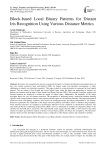
Block-based Local Binary Patterns for Distant Iris Recognition Using Various Distance Metrics
Статья научная
Nowadays iris recognition has become a promising biometric for human identification and authentication. In this case, feature extraction from near-infrared (NIR) iris images under less-constraint environments is rather challenging to identify an individual accurately. This paper extends a texture descriptor to represent the local spatial patterns. The iris texture is first divided into several blocks from which the shape and appearance of intrinsic iris patterns are extracted with the help of block-based Local Binary Patterns (LBPb). The concepts of uniform, rotation, and invariant patterns are employed to reduce the length of feature space. Additionally, the simplicity of the image descriptor allows for very fast feature extraction. The recognition is performed using a supervised machine learning classifier with various distance metrics in the extracted feature space as a dissimilarity measure. The proposed approach effectively deals with lighting variations, blur focuses on misaligned images and elastic deformation of iris textures. Extensive experiments are conducted on the largest and most publicly accessible CASIA-v4 distance image database. Some statistical measures are computed as performance indicators for the validation of classification outcomes. The area under the Receiver Operating Characteristic (ROC) curves is illustrated to compare the diagnostic ability of the classifier for the LBP and its extensions. The experimental results suggest that the LBPb is more effective than other rotation invariants and uniform rotation invariants in local binary patterns for distant iris recognition. The Braycurtis distance metric provides the highest possible accuracy compared to other distance metrics and competitive methods.
Бесплатно
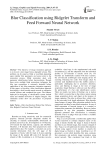
Blur Classification using Ridgelet Transform and Feed Forward Neural Network
Статья научная
The objective of image restoration approach is to recover a true image from a degraded version. This problem can be stated as blind or non-blind depending upon whether blur parameters are known prior to the restoration process. Blind restoration deals with parameter identification before deconvolution. Though there exists multiple blind restorations techniques but blur type recognition is extremely desirable before application of any blur parameters estimation approach. In this paper, we develop a blur classification approach that deploys a feed forward neural network to categories motion, defocus and combined blur types. The features deployed for designing of classification system include mean and standard deviation of ridgelet energies. Our simulation results show the preciseness of proposed method.
Бесплатно
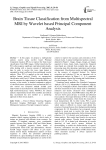
Brain Tissue Classification from Multispectral MRI by Wavelet based Principal Component Analysis
Статья научная
In this paper, we propose a multispectral analysis system using wavelet based Principal Component Analysis (PCA), to improve the brain tissue classification from MRI images. Global transforms like PCA often neglects significant small abnormality details, while dealing with a massive amount of multispectral data. In order to resolve this issue, input dataset is expanded by detail coefficients from multisignal wavelet analysis. Then, PCA is applied on the new dataset to perform feature analysis. Finally, an unsupervised classification with Fuzzy C-Means clustering algorithm is used to measure the improvement in reproducibility and accuracy of the results. A detailed comparative analysis of classified tissues with those from conventional PCA is also carried out. Proposed method yielded good improvement in classification of small abnormalities with high sensitivity/accuracy values, 98.9/98.3, for clinical analysis. Experimental results from synthetic and clinical data recommend the new method as a promising approach in brain tissue analysis.
Бесплатно
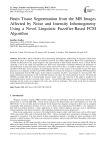
Статья научная
Brain MRI is mainly affected by noise and intensity inhomogeneity (IIH) during its acquisition. Brain tissue segmentation plays an important role in biomedical research and clinical applications. Brain tissue segmentation is essential for physicians for the proper diagnosis and right treatment of brain-related disorders. Fuzzy C-means (FCM) clustering is one of the widely used algorithms for brain tissue segmentation. Traditional FCM has the limitations of misclassification of pixels that leads to inaccurate cluster centers. Due to this, it is unable to address the issues of noise and IIH. In FCM there exists uncertainty in controlling the fuzziness of the clusters as the fuzzifier is fixed. This paper proposed a novel linguistic fuzzifier-based FCM (LFFCM) to overcome the limitations of traditional FCM during brain tissue segmentation from the MR images. In this method, a linguistic fuzzifier is used instead of a fixed fuzzifier. The spatial information incorporated in the membership function can reduce the misclassification of pixels. The proposed LFFCM can handle IIH, due to having highly accurate cluster centers. The inclusion of the adaptive weights in the membership function results in accurate cluster centers. Various brain MR images are used to evaluate the proposed technique and the results are compared with some state-of-the-art techniques. The results reveal that the proposed method performed better than the other.
Бесплатно
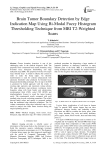
Статья научная
Tumor boundary detection is one of the challenging tasks in the medical diagnosis field. The proposed work constructed brain tumor boundary using bi-modal fuzzy histogram thresholding and edge indication map (EIM). The proposed work has two major steps. Initially step 1 is aimed to enhance the contrast in order to make the sharp edges. An intensity transformation is used for contrast enhancement with automatic threshold value produced by bimodal fuzzy histogram thresholding technique. Next in step 2 the EIM is generated by hybrid approach with the results of existing edge operators and maximum voting scheme. The edge indication map produces continuous tumor boundary along with brain border and substructures (cerebrospinal fluid (CSF), sulcal CSF (SCSF) and interhemispheric fissure) to reach the tumor location easily. The experimental results compared with gold standard using several evaluation parameters. The results showed better values and quality to proposed method than the traditional edge detection techniques. The 3D volume construction using edge indication map is very useful to analysis the brain tumor location during the surgical planning process.
Бесплатно
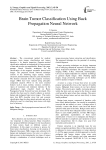
Brain Tumor Classification Using Back Propagation Neural Network
Статья научная
The conventional method for medical resonance brain images classification and tumors detection is by human inspection. Operator-assisted classification methods are impractical for large amounts of data and are also non-reproducible. Hence, this paper presents Neural Network techniques for the classification of the magnetic resonance human brain images. The proposed Neural Network technique consists of the following stages namely, feature extraction, dimensionality reduction, and classification. The features extracted from the magnetic resonance images (MRI) have been reduced using principles component analysis (PCA) to the more essential features such as mean, median, variance, correlation, values of maximum and minimum intensity. In the classification stage, classifier based on Back-Propagation Neural Network has been developed. This classifier has been used to classify subjects as normal, benign and malignant brain tumor images. The results show that BPN classifier gives fast and accurate classification than the other neural networks and can be effectively used for classifying brain tumor with high level of accuracy.
Бесплатно
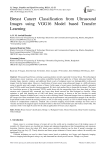
Breast Cancer Classification from Ultrasound Images using VGG16 Model based Transfer Learning
Статья научная
Ultrasound based breast screening is gaining attention recently especially for dense breast. The technological advancement, cancer awareness, and cost-safety-availability benefits lead rapid rise of breast ultrasound market. The irregular shape, intensity variation, and additional blood vessels of malignant cancer are distinguishable in ultrasound images from the benign phase. However, classification of breast cancer using ultrasound images is a difficult process owing to speckle noise and complex textures of breast. In this paper, a breast cancer classification method is presented using VGG16 model based transfer learning approach. We have used median filter to despeckle the images. The layers for convolution process of the pretrained VGG16 model along with the maxpooling layers have been used as feature extractor and a proposed fully connected two layers deep neural network has been designed as classifier. Adam optimizer is used with learning rate of 0.001 and binary cross-entropy is chosen as the loss function for model optimization. Dropout of hidden layers is used to avoid overfitting. Breast Ultrasound images from two databases (total 897 images) have been combined to train, validate and test the performance and generalization strength of the classifier. Experimental results showed the training accuracy as 98.2% and testing accuracy as 91% for blind testing data with a reduced of computational complexity. Gradient class activation mapping (Grad-CAM) technique has been used to visualize and check the targeted regions localization effort at the final convolutional layer and found as noteworthy. The outcomes of this work might be useful for the clinical applications of breast cancer diagnosis.
Бесплатно
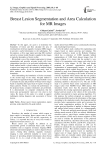
Breast lesion segmentation and area calculation for MR images
Статья научная
In this paper, our goal is to determine the boundaries of lesion and then calculate the area of existing lesion in breast magnetic resonance (MR) images to provide a useful information to the radiologists. For this purpose, at first stage region growing (RG) method and active contour model (Snake) is applied to the images to make the boundaries of lesion visible. RG method is one of the simplest approaches for image segmentation and provides accurate results with lower computation time due to its seed point initialization step. Snake method molds a closed contour to the boundary of a region in an image and is also popular in medical image segmentation studies. In the presented study, both of these methods are utilized to determine the lesion boundaries. After determining the boundaries of lesion accurately in the second stage of the study, bit-quad method is applied to the segmented images. Bit quad method is used to compute the area and perimeter of binary lesion images based on matching the logical state of regions of image to binary patterns. Finally, to evaluate the performance of the proposed study, computer simulations are performed. It is demonstrated via computer simulations that the lesion area and parameter values are very close to real values. By means of this study it is aimed to support radiologists during diagnosis and assessment of breast lesions.
Бесплатно

